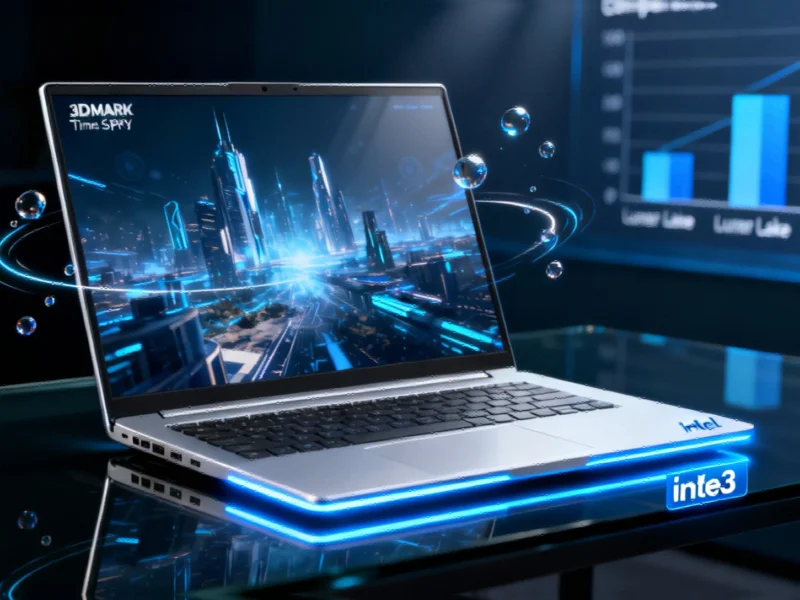TITLE: Intel’s Panther Lake Xe3 GPU Shows Stunning Performance Leap in Latest Benchmark Leak
Intel’s upcoming Panther Lake processors are generating significant buzz in the tech world, with leaked benchmarks suggesting a substantial performance improvement in integrated graphics. According to recent test results from Chinese tech site Laptop Review Club, the Xe3 GPU architecture demonstrates remarkable gains that could reshape the mobile computing landscape. This development comes amid growing industry anticipation for Intel’s next-generation graphics technology and represents a crucial step in the company’s ongoing efforts to compete with established GPU manufacturers.
Benchmark Performance Breakdown
The leaked 3DMark Time Spy results reveal impressive numbers for Panther Lake’s integrated graphics solution. Testing conducted on the flagship Core Ultra X9 388H configuration—featuring 4 P-cores, 8 E-cores, 4 LP-cores, and twelve Xe3 graphics cores—achieved a Graphics score of 6233 points using standard LPDDR5-8533 memory. When overclocking the memory to 9600 MT/s, the score increased modestly to 6300 points, suggesting the system is primarily GPU or power-limited rather than memory-bound.
This performance represents a significant leap over previous generations and competing solutions. The highest recorded Lunar Lake processor score in the 3DMark database stands at 4505 points, while AMD’s Strix Point with Radeon 890M graphics tops out at 4041 points. Even NVIDIA’s mobile GeForce RTX 3050, a discrete GPU solution, falls slightly behind with a maximum graphics score of 6148 points. The modest performance gain from memory overclocking indicates that memory bandwidth isn’t the primary constraint, unlike some competing architectures that show more dramatic improvements with faster memory.
Contextual Performance Analysis
Intel’s claimed performance improvements appear to align closely with these leaked results. The company has stated that Panther Lake’s Xe3 integrated GPU delivers “>50%” higher performance compared to Lunar Lake’s integrated graphics. However, this impressive gain must be viewed in context—the Xe3 GPU in Panther Lake is approximately 50% larger than its Lunar Lake predecessor, suggesting that architectural efficiency improvements may be more modest than raw performance numbers indicate.
Where Intel appears to have made genuine progress is in performance per watt. The company claims “more than 40%” improvement over Arrow Lake’s efficiency, though it’s worth noting that Arrow Lake uses an unusual Xe-LPG+ architecture rather than the Xe2 architecture found in Lunar Lake. The efficiency gains compared to Lunar Lake’s already-impressive performance are likely in the 10-15% range, which still represents meaningful progress in mobile computing where power efficiency is paramount. This efficiency push mirrors broader industry trends toward balancing performance with power consumption across all computing segments.
Competitive Landscape Implications
The benchmark results position Intel’s integrated graphics firmly ahead of current-generation competition. AMD’s Strix Point with Radeon 890M graphics averages just 3348 points in Time Spy Graphics scores, while Intel’s Panther Lake demonstrates approximately 85% higher performance in these leaked results. Even compared to discrete solutions, the Xe3 graphics show competitive numbers, outperforming the mobile RTX 3050’s average score of 4882 points by nearly 30%.
This performance level could potentially disrupt the entry-level discrete GPU market, similar to how integrated graphics have gradually eroded the low-end discrete segment over recent generations. The timing of these developments is particularly interesting given ongoing global supply chain considerations that affect component availability and pricing across the technology industry.
Architectural Considerations and Manufacturing
Panther Lake represents Intel’s first consumer product built on the company’s in-house 18A manufacturing process, which is currently in volume production according to company statements. The move to this advanced node likely contributes significantly to both performance and efficiency gains, enabling higher clock speeds and better power characteristics.
The Xe3 architecture itself builds upon lessons learned from both the original Xe HPG architecture and the refined Xe2 design used in Lunar Lake and Battlemage discrete GPUs. While specific architectural details remain scarce, the demonstrated performance suggests meaningful improvements in execution efficiency, memory compression, and rendering techniques. These advancements occur alongside broader technological developments happening across the computing industry as manufacturers push the boundaries of integrated graphics capabilities.
Cautious Optimism and Real-World Expectations
While the leaked benchmarks are certainly impressive, experienced observers recommend tempered expectations. Intel GPUs have historically shown stronger performance in synthetic benchmarks like 3DMark compared to real-world gaming scenarios. The Time Spy test specifically favors certain architectural strengths that may not translate perfectly to actual gaming performance.
Additionally, the test conditions for these leaked results remain somewhat unclear. Factors like thermal design, power delivery, and driver maturity can significantly impact real-world performance. As with any pre-release performance data, these results should be considered indicative rather than definitive until independent verification becomes available.
Industry analysts will be watching closely to see how these performance claims hold up in retail products expected to launch in the coming months. If Intel can deliver on these promising benchmarks with stable drivers and consistent performance, the company could significantly strengthen its position in both the mobile computing and entry-level gaming markets.
Based on reporting by {‘uri’: ‘hothardware.com’, ‘dataType’: ‘news’, ‘title’: ‘HotHardware’, ‘description’: ‘HotHardware is your trusted source for technology news and expert reviews of computers, PC components, laptops, tablets, smartphones and gadgets for enthusiasts, consumers, gamers and IT pros’, ‘location’: {‘type’: ‘place’, ‘geoNamesId’: ‘4930956’, ‘label’: {‘eng’: ‘Boston’}, ‘population’: 617594, ‘lat’: 42.35843, ‘long’: -71.05977, ‘country’: {‘type’: ‘country’, ‘geoNamesId’: ‘6252001’, ‘label’: {‘eng’: ‘United States’}, ‘population’: 310232863, ‘lat’: 39.76, ‘long’: -98.5, ‘area’: 9629091, ‘continent’: ‘Noth America’}}, ‘locationValidated’: False, ‘ranking’: {‘importanceRank’: 338734, ‘alexaGlobalRank’: 57783, ‘alexaCountryRank’: 28985}}. This article aggregates information from publicly available sources. All trademarks and copyrights belong to their respective owners.



